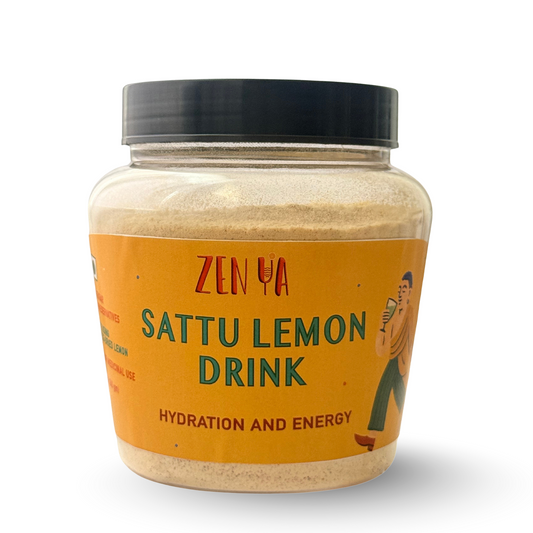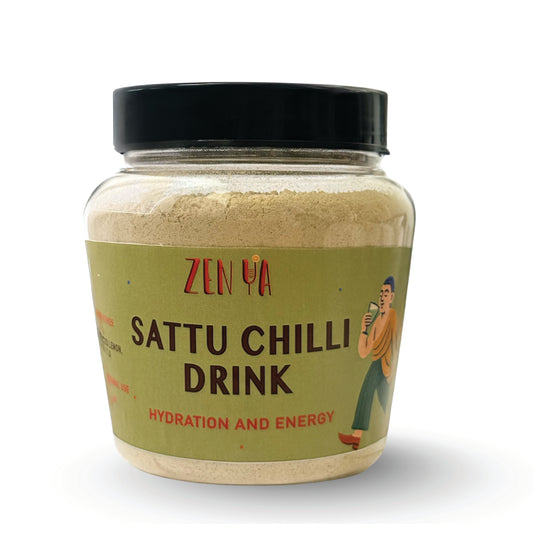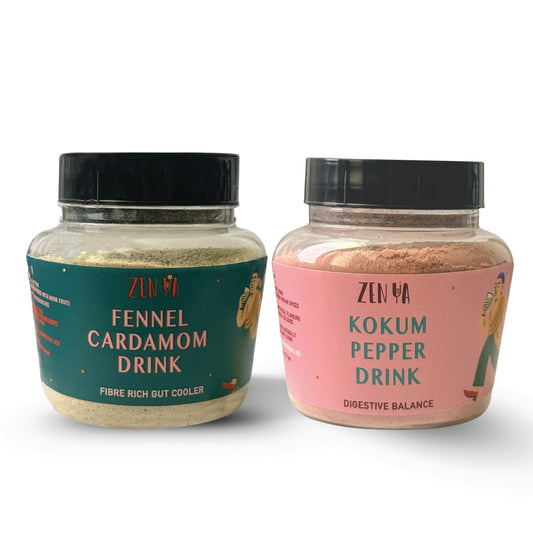
Sattu vs Protein Powder
Share
The fitness world today is full of protein shakes, supplements, and powders. But if you grew up in India, there’s a good chance your grandmother already had a protein-rich superfood in her kitchen, Sattu.
Made from roasted Bengal gram (chana), sattu has been a staple for generations, delivering protein, fibre, and minerals in a minimally processed form. On the other hand, modern protein powders, from whey to soy to pea, are designed to deliver concentrated protein with fewer carbs and fats.
So which one should you choose? The answer depends less on marketing hype and more on your lifestyle, activity level, and overall health goals.
What is Sattu?
Sattu is made by dry-roasting whole Bengal gram and grinding it into a fine powder. The roasting process enhances flavour, improves digestibility, and extends shelf life, all without preservatives.
Per 30g (~2 tbsp) serving, sattu provides:
- Calories: ~111 kcal
- Protein: ~6g
- Carbs: ~18g
- Fibre: ~4.5g
- Fat: ~1.8g
- Rich in iron, potassium, magnesium, and folate
It’s naturally gluten-free, plant-based, and low glycaemic, meaning it releases energy slowly, keeping you fuller for longer.
What is Protein Powder?
Protein powders are concentrated protein supplements, often derived from:
- Whey (from milk)
- Casein (from milk)
- Soy (plant-based)
- Pea (plant-based)
- Blends (combinations)
A 30g scoop of whey protein typically provides:
- Calories: ~120 kcal
- Protein: ~24g
- Carbs: ~3g
- Fibre: 0g
These powders are designed to help people hit higher protein targets quickly with minimal carbs or fats.
How Much Protein Do You Really Need?
Your choice between sattu and protein powder depends on how active you are and your body’s protein requirements.
| Activity Level | Protein Intake per kg body weight / day* | Example for 60kg person |
| Sedentary / Light Activity | 0.8 - 1.0 g | 48 - 60 g |
| Moderate Activity (Yoga, Walking, Pilates) | 1.0 - 1.2 g | 60 - 72 g |
| Endurance Training (Running, Cycling) | 1.2 - 1.6 g | 72 - 96 g |
| Strength / Muscle Gain | 1.6 - 2.2 g | 96 - 132 g |
*Sources: ICMR-NIN Dietary Guidelines and American College of Sports Medicine.
What this means:
- If you practise yoga, walk daily, or do light to moderate workouts, sattu combined with your regular meals can easily meet your protein needs.
- If you’re into intense strength training, bodybuilding, or competitive sports, you might find it challenging to reach 100+ grams protein per day without a concentrated source like protein powder.
Nutrition Face-Off: Sattu vs Protein Powder
| Nutrient (per 30g) | Sattu | Whey Protein | Soy Protein | Pea Protein |
| Calories | ~111 | ~120 | ~110 | ~115 |
| Protein | ~6g | ~24g | ~23g | ~22g |
|
Fibre |
~4.5g | 0g | 1g | 1-2g |
| Carbs | ~18g | ~3g | ~2g | ~2g |
| Processing Level | Minimal | High | Medium | Medium |
Health Benefits: The Different Strengths
Sattu
Protein + Fibre → Keeps you full, supports digestion.
Low GI → Helps manage blood sugar.
Mineral-rich → Iron, magnesium, potassium for daily wellness.
Hydrating when consumed as a drink.
Protein Powder
High Protein Density → Ideal for intense muscle-building goals.
Fast Absorption (especially whey) → Good for post-workout recovery.
Low Carb/Fat → Useful for calorie-controlled high-protein diets.
Drawbacks to Consider
Sattu: Lower protein per serving, higher carbs (a positive if you need energy, but not ideal for low-carb diets).
Protein Powder: Highly processed, often contains artificial sweeteners or additives, more expensive, and may cause digestive issues in some people.
Cost & Accessibility
- Sattu: ₹60–₹100/kg when bought as plain roasted Bengal gram flour, widely available in Indian markets.
- Protein Powders: ₹1,500–₹6,000/kg depending on brand, source, and type.
While plain sattu is the most budget-friendly option, it usually requires home preparation, flavouring, and portion control. Zen Ya’s ready-to-mix sachets are crafted with premium roasted Bengal gram and freeze-dried ingredients like lemon, mint, and roasted cumin, a process that locks in flavour, aroma, and nutrition without preservatives. This ensures consistent taste, optimal nutrition, and on-the-go convenience for those who want the benefits of sattu without the hassle of prep.
Sustainability & Local Impact
Sattu supports local agriculture, Bengal gram requires low water and improves soil health (FAO – Pulses and Sustainability). Most protein powders are made from imported raw materials, with a higher carbon footprint.
Which One Should You Choose?
If your goal is everyday wellness, yoga, walking, or moderate activity: Sattu is a natural, nutrient-dense, and affordable choice that meets your protein needs while supporting digestion and hydration.
If your goal is intense muscle gain or high-performance athletics: Protein powder offers concentrated protein to help hit high daily targets.
Best of both worlds: Use sattu for your daily meals/snacks and protein powder only when your training demands it.
Zen Ya: Modern Sattu for the Health-Conscious
At Zen Ya, we’ve taken the nutritional power of sattu and blended it with lemon, mint, and roasted cumin to create ready-to-mix functional drinks. Perfect for:
- Morning energy
- Breakfast replacement
- Post-workout recovery
- Healthy midday snacks
Our sachets are:
- Portion-controlled for calorie awareness
- Free from added sugar & preservatives
- Designed for hydration and digestion support
Whether you’re a yoga enthusiast, a weekend hiker, or just someone who wants to eat clean, Zen Ya makes it simple to enjoy sattu’s benefits every day.
Final Thoughts
Sattu and protein powder serve different purposes and both can be part of a healthy lifestyle. If your activity level is light to moderate, sattu offers enough protein along with fibre, minerals, and hydration benefits that most protein powders lack.
For those training hard and chasing higher protein targets, protein powders can fill the gap. But for most people, especially in India, starting with a natural option like sattu, made even more convenient with Zen Ya, is the smart, sustainable choice.




